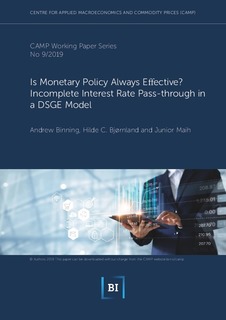| dc.contributor.author | Bjørnland, Hilde C. | |
| dc.contributor.author | Binning, Andrew | |
| dc.contributor.author | Maih, Junior | |
| dc.date.accessioned | 2019-11-27T14:39:58Z | |
| dc.date.available | 2019-11-27T14:39:58Z | |
| dc.date.issued | 2019-11 | |
| dc.identifier.issn | 1892-2198 | |
| dc.identifier.uri | http://hdl.handle.net/11250/2630790 | |
| dc.description.abstract | We estimate a regime-switching DSGE model with a banking sector to explain incomplete and asymmetric interest rate pass-through, especially in the presence of a binding zero lower bound (ZLB) constraint. The model is estimated using Bayesian techniques on US data between 1985 and 2016. The framework allows us to explain the time-varying interest rate spreads and pass-through observed in the data. We find that pass-through tends to be delayed in the short run, and incomplete in the long run. All this impacts the dynamics of the other macroeconomic variables in the model. In particular, we find monetary policy to be less effective under incomplete pass-through. Furthermore, the behavior of pass-through in the loan rate is different from that of the deposit rate shocks. This creates asymmetric dynamics at the zero lower bound, and incomplete pass-through exacerbates that asymmetry. | nb_NO |
| dc.language.iso | eng | nb_NO |
| dc.publisher | BI Norwegian Business School | nb_NO |
| dc.relation.ispartofseries | CAMP Working Paper Series;09/2019 | |
| dc.subject | Banking sector | nb_NO |
| dc.subject | incomplete or asymmetric interest rate pass-through | nb_NO |
| dc.subject | DSGE | nb_NO |
| dc.title | Is Monetary Policy Always Effective? Incomplete Interest Rate Pass-through in a DSGE Model | nb_NO |
| dc.type | Working paper | nb_NO |
| dc.source.pagenumber | 68 | nb_NO |
